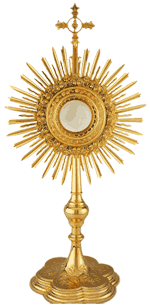Jesus Brothers and sisters: I received from the Lord what I also handed on to you, that the Lord Jesus, on the night he was handed over, took bread, and, after he had given thanks, broke it and said, “This is my body that is for you. Do this in remembrance of me.” In the same way also the cup, after supper, saying, “This cup is the new covenant in my blood. Do this, as often as you drink it, in remembrance of me.” (1 Cor. 11:23-25)
In terms of a feast in the Catholic Church, today’s Solemnity of the Body and Blood of Christ (“Corpus Christi” in Latin) is a fairly recent one. The addition of this special feast to the Church calendar was primarily due to the petitions of a Belgium nun named Juliana who lived in the 13th century. From a young age, Juliana had a great love for the Blessed Sacrament and longed for a special feast in its honor. Her desire was increased by a vision she had of the Church under the appearance of the full moon having one dark spot. The spot signified the absence of a day specifically honoring the Blessed Sacrament. In 1208 Juliana also had a vision of Christ in which He instructed her to institute the Feast of Corpus Christi. The vision was repeated for the next 20 years, but she kept it a secret. When she finally told her confessor, he relayed it to the bishop.
Juliana petitioned a number of bishops and priests to institute the Feast, including Robert de Thorete. Since bishops could order feasts in their dioceses, Bishop Robert convened a synod in 1246 and ordered a Corpus Christi celebration to be held each year.
The celebration of Corpus Christi became universal only after Juliana and Bishop Robert died. In 1263 Pope Urban IV (also from Liège) investigated claims of a Eucharistic miracle at Bolsena, in which a consecrated host began to bleed. In 1264 he issued the papal bull making Corpus Christi a feast throughout the entire Latin Rite. This was the very first papally sanctioned universal feast in the history of the Latin Rite.
While the institution of the Eucharist is celebrated on Holy Thursday, that particular liturgy also commemorates the washing of the apostles’ feet, the institution of the priesthood and the agony in the Garden of Gethsemane. Corpus Christi was established to be specifically focused on the Holy Eucharist.
A new liturgy for Corpus Christi was composed by St. Thomas Aquinas. This liturgy has come to be used not only on the Feast of Corpus Christi itself but also throughout the year at events related to the Blessed Sacrament. The famous hymn that Aquinas composed for Vespers of Corpus Christi, Pange Lingua, is also used on Holy Thursday during the procession of the Blessed Sacrament to the altar of repose and at Benediction of the Blessed Sacrament along with O Salutaris Hostia the last two verses of Verbum Supernum Prodiens, Aquinas’ hymn for Lauds of Corpus Christi.
Since Jesus Christ is truly present in the Eucharist, then we are united to Him and to each other whenever we are united to the Eucharist. So even though I am in Rome for the closing of the Year for Priests, I am with everyone at Good Shepherd Parish whenever we are each gathered around the Altar. What a great consolation and what a great reminder of Heaven! Heaven is being with Jesus forever, and each Mass is a small taste.
Rev. Msgr. Christopher H. Nalty
msgr.nalty@gmail.com




